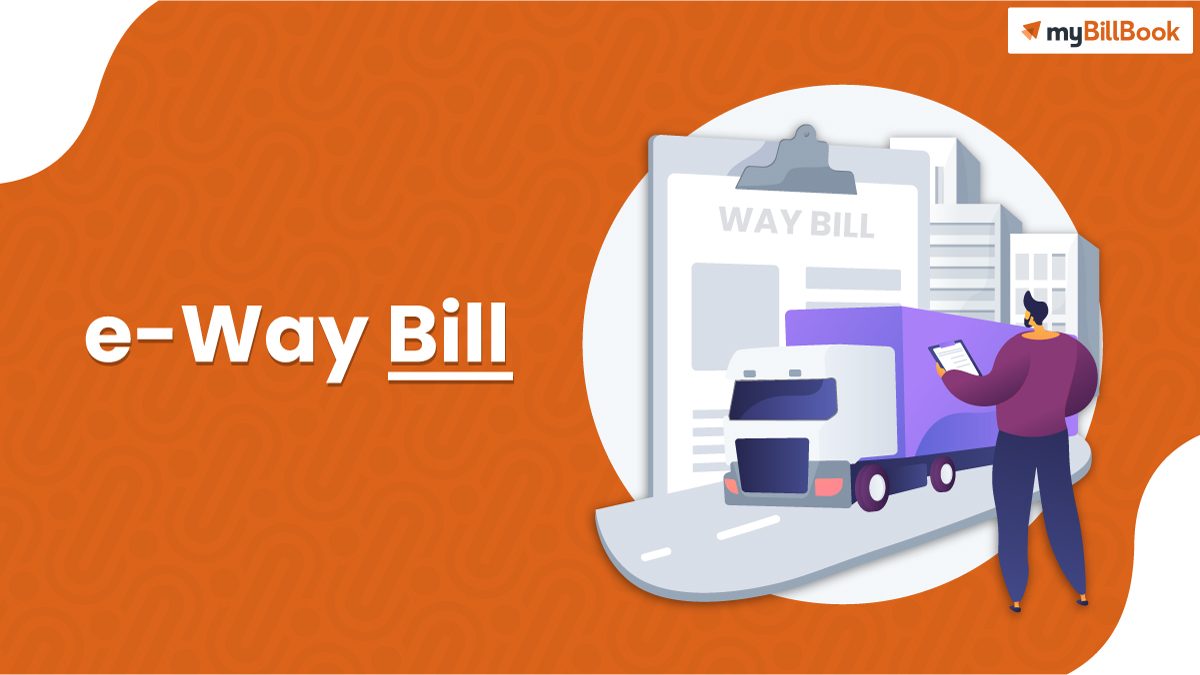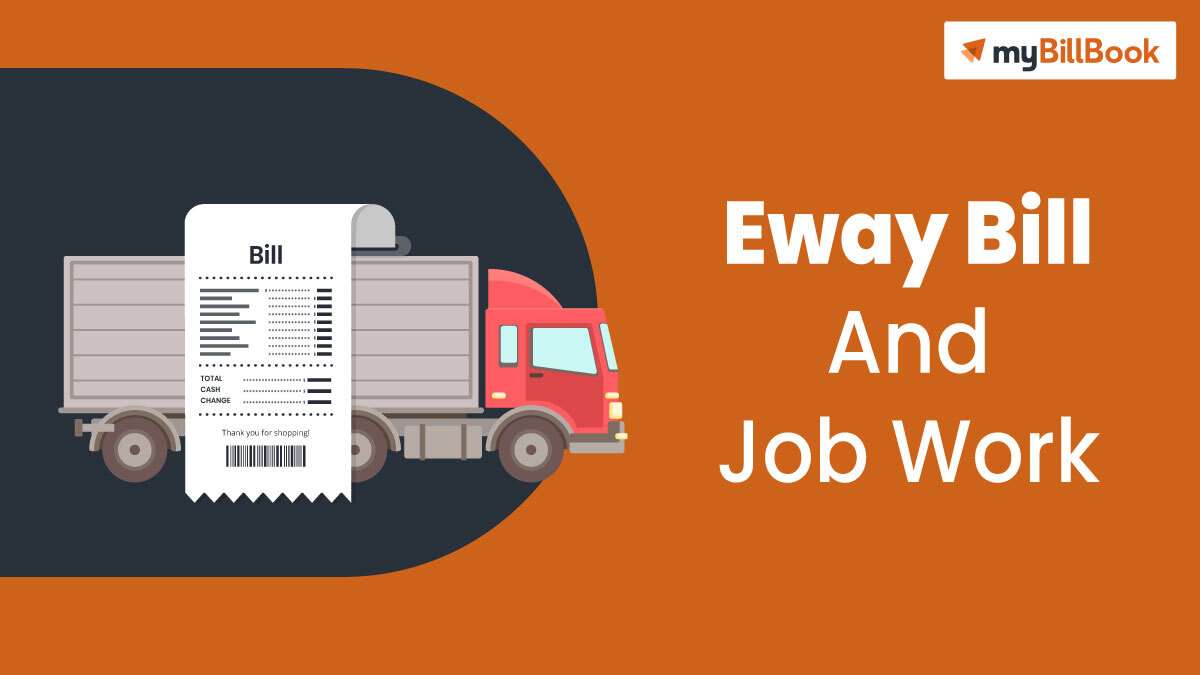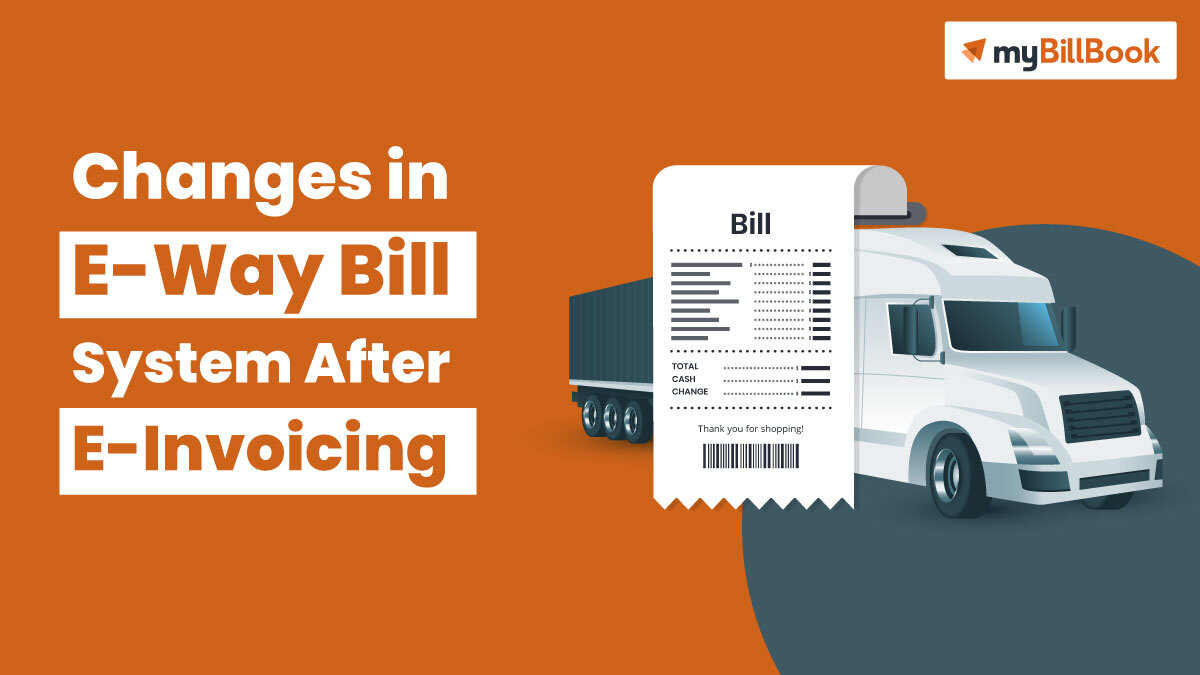An e Way Bill is a document essential for transporting goods worth more than ₹50,000 in India under the Goods and Services Tax (GST) framework. Introduced to streamline logistics and reduce tax evasion, the e Way Bill system has become a cornerstone of efficient supply chain management for businesses.
As we step into 2025, it is crucial for businesses, especially Small and Medium Enterprises (SMBs), to stay updated on the latest changes and best practices related to the e-Way Bill system. This guide is designed to help you navigate the e-Way Bill process with ease, ensuring compliance while optimizing operations.
In this page, you will find the following topics. Clicking on the respective links will take you to the detailed pages.
- e-Way Bill Meaning
- e-Way Bill Format
- e-Way Bill Rules 2025
- How to Register on the e-Way Bill Website
- How to Generate e-Way Bills
- e-Way Bill Validity
- e-Way Billing Through Mobile SMS
- e-Way Bill Pin-to-Pin Distance Calculation
- State-wise e-Way Bill Limit
- How to Cancel e-Way Bills
- How to Unblock e-Way Bill
- e-Way Bill Portal Details
- Cases When e-Way Bill is Not Required Cases
- e-Way Bill for Import and Export
- How to Print e-Way Bill
- How to Update Multiple Vehicles on e-Way Bill
- How to Generate Consolidated e-Way Bills
- e-Way Bill Generation by End-Consumer
- Penalty for Expired e-Way Bill
- Bill To and Ship Under e-Way Bill
- Transporter ID in e-Way Bill
- Changes in e-Way Bill After e-Invoicing
What is an e-Way Bill | e Way Bill Meaning
An e-way bill is an electronic document required for the movement of goods valued above a specified limit. e-Way bill generation is a compliance requirement. The person causing the movement of goods must upload relevant information and generate an e-way bill on the GST portal before transporting the goods. The movement of goods could be for supply or reasons other than supply; an e-way bill is a must according to Rule 138 of CGST Rules.
When was e-Way Billing Introduced?
The e-way bill system for inter-state movement of goods began on April 1, 2018, across India. However, for intra-state goods movement, the e-way bill requirements were determined by individual state governments and implemented at various times in 2018. As a result, an e-way bill is now necessary for both inter-state and intra-state transportation of goods exceeding specific values. While the limit for inter-state movement remains consistent, different states have opted for varying thresholds for intra-state goods transport. We will discuss them in detail in the next section.
Purpose of e-Way Billing
- e-Way billing was introduced under the GST regime to bring transparency and traceability to the movement of goods.
- Facilitate faster movement of goods, improving truck turnaround times.
- Supports the logistics industry by enabling longer distances, reduced travel time, and lowered costs.
- Eliminates wait times at checkposts and speeds up the movement of goods, leading to the most efficient utilisation of vehicles and resources.
Ensures compliance with GST laws, monitors goods movement, and helps prevent tax evasion from the department’s perspective.
By going back to the basics and understanding what is invoicing, one can better appreciate the role of e-way billing in ensuring smooth and compliant goods transportation.
e-Way Bill New Rules 2025 | Latest Notifications
- e-Invoice Details Mandatory for e-Way Bill Generation
From 1 March 2024, e-Way generation will not be allowed without e-invoice details for all applicable taxpayers. This new regulation applies to all B2B and export transactions. For B2C and other non-supply related transactions, this new eway bill rule is not applicable.
- 6 digit HSN Code Must for all the B2B and Export Transactions
Starting 1st February 2024, all taxpayers with annual turnover over Rs.5 Crores must provide at least 6 digit HSN codes while generating e-way bills for all B2B and Export transactions. Those with a turnover less than Rs.5 Crore must provide 4 digit HSN Code.
When is an e-way Bill Required?
e-Way Bill Requirement for Inter-State Movement of Goods
An e-way bill is required only when the consignment value exceeds Rs.50,000 for state-to-state or inter-state movement of goods in a motorised vehicle. This means, if you’re carrying goods worth less than Rs.50,000, you don’t have to generate an eway bill. However, you must carry relevant documents like sales invoices, delivery challans, debit notes, credit notes or other related documents when an e-way bill is not required.
e-Way Bill Requirement for Intra-State Movement of Goods
For intra-state movement or within the state movement of goods, the respective state governments have decided the thresholds. Each state has a different threshold to generate e-way bills, and there are a few exemptions for certain goods and services. For detailed information visit e-way bill limits in different states.
How to Register on the e-Way Bill Website
eWay bill registration is mandatory to generate eway bills on the official eway bill portal www.ewaybillgst.gov.in/. Registered/unregistered suppliers and registered/unregistered transporters, must register on the eway bill website to generate eway bills. Here is the step-by-step guide to register on eway bill official website.
How to Generate e-Way Bills
An eway bill needs to be generated before initiating the delivery process. The GST council has made eway bill generation mandatory for all GST-registered businesses and enrolled transporters. Here is a step-by-step guide to creating e-Way Bills using the GST portal.
Who Should Generate e-Way Bill?
- Registered Individual – either the consignor, consignee, transporter, or receiver, if the transportation is being done in own or hired vehicle or by railways, air or by ship.
- Transporter – When the goods are handed over to him for transportation by road. In such cases, the transporter needs to update Part B of the e-way bill, while Part A details need to be furnished by a registered person.
- The transporter can also generate Part-A after getting authorisation from the consigner or consignee for the same.
- If goods are moved within a State or Union Territory, covering a distance of up to 50 KM, from the consignor’s business place to the transporter’s location for subsequent transportation, the supplier, recipient, or transporter may not need to provide conveyance details in Part-B of FORM GST EWB-01.
- Job Worker – If goods are dispatched from a principal in one state to a job-worker in any other state, the e-Way Bill must be created by either the principal or the job worker, if they are registered, regardless of the consignment’s value.
Similarly, when handicraft goods move from one state to another by an individual exempt from registration, that person must generate the e-Way Bill, irrespective of the consignment’s value.
e-Way Bill Validity
Understand the timeframes for which e-Way Bills remain valid based on distance and type of vehicle. Learn how to calculate distance using e-Way Bill Pin-to-Pin Distance Calculation.
e-Way Billing Through Mobile SMS
e-Way billing through mobile or mobile e-Way Bill is an SMS-based generation of e-way bills on mobile. This service is introduced for small business owners who require less number of e-way bills or don’t have infrastructure like PCs or laptops to generate e-way bills.
e-Way Bill Pin-to-Pin Distance Calculation
eWay bill PIN to PIN distance calculation is a crucial step in eWay bill generation as it is critical for determining the validity of an eway bill. The e-way bill distance must be accurately calculated to avoid penalties or compliance issues.
State-wise e-Way Bill Limit
Know the e-Way bill limit in various Indian states. Knowing the inter-state movement, intra-state movement, and each state’s eway bill thresholds in detail is crucial for uninterrupted transport between states.
How to Cancel e-Way Bills
Learn how to cancel incorrect e-Way Bills within the stipulated timeframe. The page also discusses eway bill cancellation time, how to cancel eway bills after 24 hours, how to reject eway bills and other important information related to eway bill cancellation.
How to Unblock e-Way Bill
Unblocking an eway bill is crucial to continue transporting goods from the seller to the buyer. A blocked GSTIN would negatively impact any business if not taken care of immediately. Understand the process to unblock e-Way Bill generation when a GSTIN is temporarily disabled.
e-Way Bill Portal Details
e Way Bill login portal is the official portal for registering and generating e-way bills. If you’re new to the eway bill login portal and e way billing system, the eWay Bill Portal Details page explains the various services available on the website.
Cases When e-Way Bill is Not Required
Know the specific situations where generating an e-Way Bill is exempted. Perfect for businesses transporting exempted goods or operating below threshold limits.
e-Way Bill for Import and Export
eWay bill for exports is part of the eway bill system. Know the the key aspects of generating an e-way bill for exports and imports and the requirements that exporters and importers must fulfil.
How to Print e-Way Bill
A guide to printing e-Way Bills directly from the portal. Know the different methods to print an eway bill quickly so that your shipments move without delays.
How to Update Multiple Vehicles on e-Way Bill
Learn how to update transportation details on an e-way bill when goods are transferred across multiple vehicles. The multi-vehicle updation allows transporters to fill in the numerous conveyance details after generating the e-way bill.
How to Generate Consolidated e-Way Bills
Simplify the management of multiple consignments by generating a single consolidated e-Way Bill. Perfect for transporters managing bulk movements.
e-Way Bill Generation by End-Consumer
Understand scenarios where end-consumers are required to generate e-Way Bills. Step-by-step guide to generate an e-way bill by an unregistered person or a citizen is also available.
Penalty for Expired e-Way Bill
Learn about the penalties of transporting goods with an expired e-Way Bill, and how to avoid them by understanding e-Way Bill Validity.
Bill To and Ship To Under e-Way Bill
A detailed explanation of managing “Bill To” and “Ship To” addresses in an e-Way Bill, especially relevant for drop shipments.
Transporter ID in e-Way Bill
Understand the role of Transporter ID in the e-Way Bill system and its significance for seamless goods movement, especially in Interstate and Export Transactions.
Changes in e-Way Bill After e-Invoicing
The goal of integrating the e-invoicing and e-way bill systems is to simplify and automate the process as a whole. Know the changes in e-way bill system after e-invoicing was introduced.
e-Way Bill Enforcement | Who Will Check e-Way Bills
The Commissioner or an authorized officer can instruct any officer to stop any vehicle to check its e-way bill or e-way bill number for both interstate and intrastate movements of goods. Physical inspections of vehicles can also be conducted by the appropriate officer as authorized by the Commissioner. If there’s specific information about tax evasion, any officer, with the necessary approval, can perform a physical inspection of a particular vehicle.
After inspecting goods in transit, the proper officer must file an online summary report (Part-A of FORM GST EWB-03) within 24 hours, and the final report (Part-B of FORM GST EWB-03) within 3 days of the inspection.
Once a physical verification of goods on a vehicle has been conducted in a state or another state, there won’t be another verification unless there’s new specific information related to tax evasion.
If a vehicle is detained for over 30 minutes, the transporter can upload this information using FORM GST EWB-04 on the common portal.
Penalty for Minor Errors in eWay Bills
Minor errors in e-Way bills like the ones mentioned below won’t lead to confiscation or proceedings under Section 129 of the CGST Act.
- Spelling mistakes in the consignor or consignee’s name, as long as the GSTIN is correct.
- Error in the PIN code, provided that the consignor and consignee addresses are accurate and the PIN code error doesn’t extend the e-way bill’s validity.
- Minor errors in the consignee’s address that don’t alter the locality or other crucial details.
- Errors in 1 or 2 digits of the document number on the e-Way Bill.
- Errors in the 4 or 6-digit level of HSN, given that the first 2 digits of the HSN are accurate and the tax rate mentioned is correct.
- Errors in 1 or 2 digits/characters of the vehicle number.
For these situations, penalties of Rs.500 each under Section 125 of the CGST Act and the respective State GST Act and Rs.1,000 under the IGST Act can be imposed for every consignment. Confiscation won’t occur for these minor typographical mistakes.
FAQs on e-Way Bill
What is the use of e-way bill?
The e-way bill is for tracking the movement of goods worth over specified amounts across states borders.
What are the benefits of e-way bill?
It simplifies and tracks the movement of goods, reducing tax evasion and ensuring compliance.
What is the distance limit for e-way bill?
It varies based on cargo type. Generally, for non-ODC, it’s 200 KM or part thereof.
Is e-way bill required within 50 KM?
No, it’s not required for distances less than 50 KM.
Is e-way bill required for transport by train?
When goods are transported via rail, there’s no need to carry the e-way bill alongside the goods. However, the in charge of the conveyance (railways) must carry the invoice, delivery challan, or bill of supply, as applicable, along with the goods.
Can we generate e-way bill without a vehicle number?
Yes, an e-way bill can be generated without a vehicle number and updated later.
What is the difference between GST bill and e-way bill?
A GST bill details the transaction, while an e-way bill tracks the movement of goods.
What is the validity of e-way bill?
For distances under 200KM, it’s one day from generation, extending by one day for every additional 200KM.
How do I generate an e-way bill from my phone?
Using the e-way bill mobile app or the official portal.
How do I log into e-way bill for the first time?
Use your GSTIN to register and create a username and password.
How do I generate an e-way bill by SMS?
Send a specific format SMS to the designated number.
How do I extend my e-way bill validity?
Update the details in Part-B of FORM GST EWB-01 within 8 hours of expiry.
What is 2-factor authentication in e-way bill?
A security measure requiring two forms of verification for e-way bill generation.
Can we generate e-way bill for non-GST customers?
Yes, an e-way bill can be generated for both GST and non-GST customers.
How do I upload an e-way bill on the portal?
Log in, go to the ‘Generate EWB’ section, fill in the details, and upload.
What is the validity of an e-way bill for 300KM?
It would be 2 days from the date of generation.
What is the minimum distance required for an e-way bill?
There’s no minimum distance; it depends on the value and type of goods.
Is an e-way bill mandatory for below Rs.50,000?
No, it’s not mandatory for goods worth less than Rs.50,000.
What is exempt from e-way bill?
Certain goods specified under rules and notifications might be exempt.
Is an e-way bill compulsory?
Yes, for the movement of goods over the prescribed limit.
In which cases is an e-way bill not required?
For specific exempted goods or distances below the stipulated limit.
Where is an e-way bill required?
Primarily for the inter and intrastate movement of goods above the defined value.
What documents are required for distances less than 50 km?
No e-way bill is required for distances below 50 km. However, the in charge of the conveyance must carry the invoice, delivery challan, or bill of supply, as applicable.
What is the penalty for not taking an e-way bill?
Penalties vary, but it can include fines and the detention of goods.
What is the disadvantage of an e-way bill?
Complexity in generating and managing eway bills is a drawback. This can be eliminated by using reliable e-way billing software.







